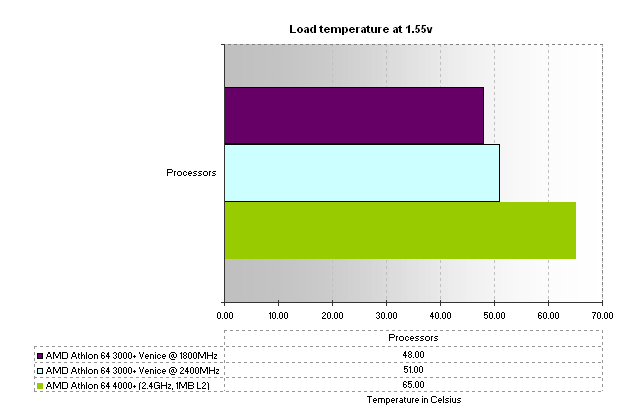|
|
AMD Athlon 64 3000+ E3 Review
[Abstract]
Final thoughtsAdvertismentThere's much to like about a processor that hits a 50% overclock with almost default voltage and goes that bit higher with a touch more VCore, especially when it only ...
[Content] PCDigitalMobileGame
System setup and notesAdvertisment

Hardware and Software Test Platforms | System | Intel Pentium (4) System | AMD Athlon 64 System | | Processor(s) | Pentium 4 530J
Pentium 4 570J
Pentium 4 670
Pentium D 820
Pentium XE 840 | Athlon 64 3000+
Athlon 64 3500+
Athlon 64 4000+
Athlon 64 FX-55
Athlon 64 X2 4800+ | | Mainboards | Intel D955XBK i955XE | ABIT Fatal1ty AN8 nForce4 Ultra
ASUS AN8 SLI for X2 4800+ | | Memory | 2 x 512MB Corsair XMS2-5400UL | 2 x 512MB Corsair Xpert XL DDR-400 | | Timings | 3-2-2-8 @ 533MHz | 2-2-2-5 @ 400MHz | | BIOS Version | BK95510J.86A.1452.EB | BIOS -13 for ABIT AN8 - 23/03/05 for A8N-SLI | | Disk Drive | 160GB Western Digital PATA | | Graphics Card | ATI RADEON X850 XT PE
CATALYST 5.3 | | Operating System | Windows XP Professional, SP2 | | Mainboard Software | Intel INF Update Utility 7.0.0.1019 | NVIDIA nForce4 Platform Driver 6.39 |
Benchmark Software HEXUS.in-house Cryptography Benchmark
Pifast Benchmark
ScienceMark 2.0 (7th February 2005)
Realstorm 2004
CINEBENCH 2003
HEXUS.in-house MP3 Encoding Benchmark using LAME 3.97a (Intel HT compiler) - 701MB WAV
Microsoft Movie Maker 2.1
picCOLOR 32-bit v4.0
KribiBench v1.1
3DMark2001SE b330
UT2003 - We custom bot test
DOOM 3 v1282
Far Cry v1.3
Notes
CPU naming has become confusing of late. MHz is no longer the 'in' term for defining a processor's performance. The brief table below states the clock speed, cache, and retail price for the models listed above.
| CPU | Clock speed | L2 cache | Core and process | Additional features | Retail price | | Athlon 64 3000+ | 1.8GHz | 512KB | Venice - 90nm | SSE 3 | ?05 | Athlon 64 3500+ | 2.2GHz | 512KB | Winchester - 90nm | | ?79 | Athlon 64 4000+ | 2.4GHz | 1MB | Clawhammer - 130nm* | | ?40 | Athlon 64 FX-55 | 2.6GHz | 1MB | Clawhammer - 130nm* | Multiplier-unlocked | ?50 | Athlon 64 X2 4800+ | 2.4GHz | 2MB - 1MB per core | Toledo - 90nm | Dual core | ?50 | Pentium 4 530J | 3.0GHz | 1MB | Prescott | | ?15 | Pentium 4 570J | 3.8GHz | 1MB | Prescott | | ?00 | Pentium 4 670 | 3.8GHz | 2MB | Prescott | EMT64 | ?50 | Pentium D 820 | 2.8GHz | 2MB - 1MB per core | Prescott | Dual core | ?85 | Pentium XE 840 | 3.2GHz | 2MB - 1MB per core | Prescott | Dual core, HT | ?00? |
* Athlon 64 4000+ is also available in 90nm form. It based on the San Diego core, which is just the Venice with double the L2 cache.
With due appreciation of the pricing for various top-end CPUs, it's prudent to compare the Athlon 64 3000+ Venice's performance against a Pentium 4 530J. You can compare the overclocked performance to anything you like.
Hot or not?
I mentioned that Venice cores were recipients of both SOI and DSL technology. They should, in theory, lower the CPU's heat output when compared to older Clawhammer- and Winchester-based processors running at a similar speed. To test this notion, an Athlon 64 4000+ (Clawhammer core, 193mm?die size) was run at its default 1.5v operating voltage and subjected to 15 minutes of Prime95's torture test. The same test was run on the Athlon 64 3000+, using the same voltage and speed. On both occasions the heatsink and CPUs were cleaned and a fresh coat of TIM was applied. Note that the Venice core is only 83mm? so heat generated is dissipated over a smaller area. Readings were taken from ABIT's GuruEQ system-monitoring software.

At the same voltage and speed, then, the Venice 3000+ was a full 14c cooler than the 1MB L2 cache-equipped Athlon 64 4000+.
|
|
|

